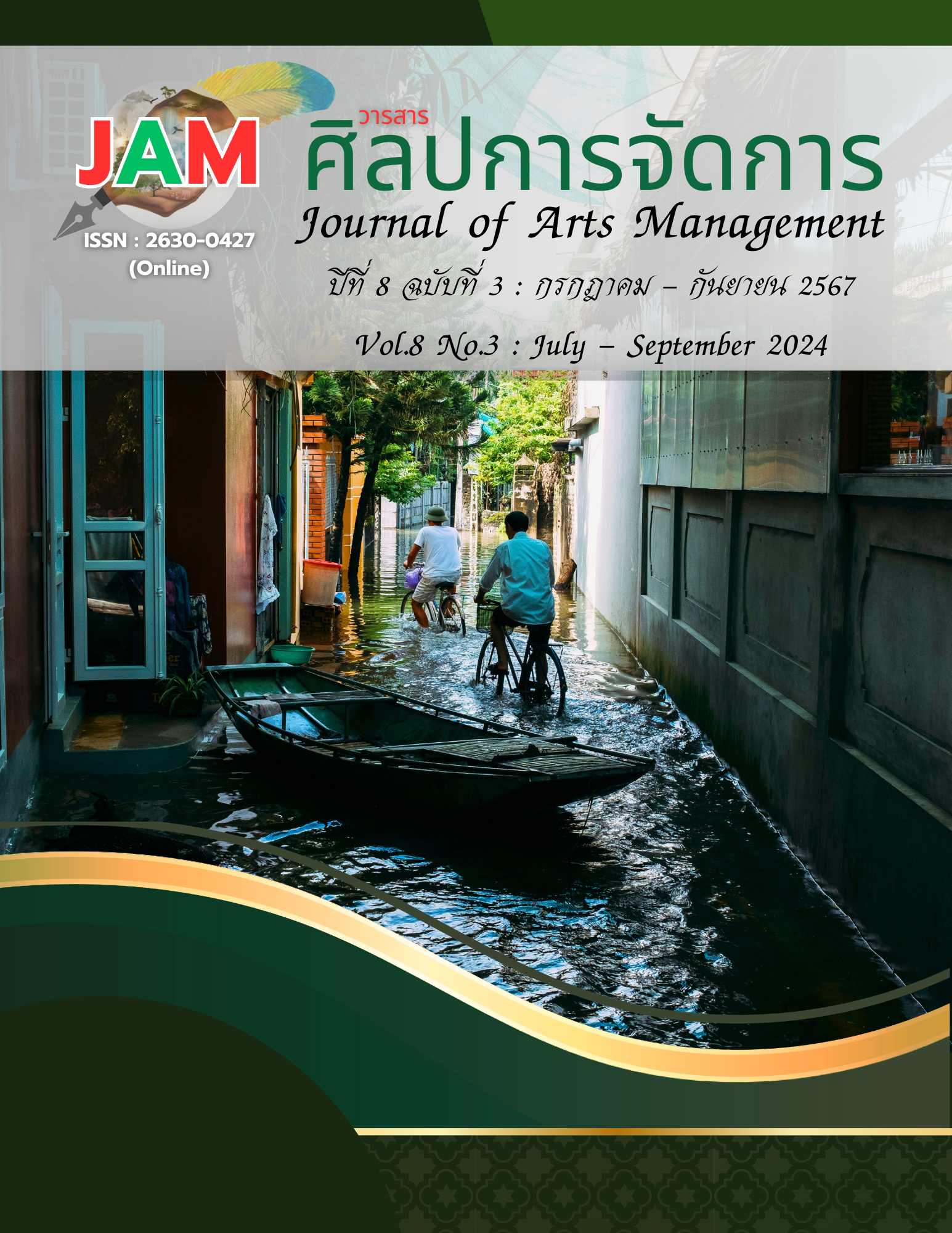Factors Influencing the Availability of Operational Support System: Prototypes Case Study of the Faculty of Business Administration Rajapark Institute
Main Article Content
Abstract
The study investigates the influential factors on the readiness to adopt a prototype of a support system for operational practices through a case study of the Faculty of Business Administration, Rajapak Institute. This research adopts both quantitative and qualitative approaches to evaluate the factors influencing the readiness to adopt a prototype support system to enhance its efficacy in meeting user needs. Data collection involves administering questionnaires and conducting experimental trials of the prototype system. The sample group consists of 40 faculty members selected using Krejcie & Morgan's table. Statistical analyses include percentages, means, standard deviations, and correlation analyses.
Perceived usefulness had the highest level of influence on system readiness, with a mean rating of 4.67, followed by perceived ease of use with a mean rating of 4.41. Organizational structure had an influence rating of 3.61, while management support had a rating of 2.74. A moderate positive correlation (r = 0.64) existed between perceived ease of use and system readiness, representing the highest influence. Perceived usefulness correlated moderately positively (r = 0.40) with system readiness, representing the second-highest influence. Management support showed a weak positive correlation (r = 0.09) with system readiness, representing the lowest influence. Organizational structure correlated moderately positively (r = 0.45) with system readiness. Overall, as perceptions (x) increase, there is a tendency for increased system readiness (y), at a statistically significant level of 0.05.
Article Details

This work is licensed under a Creative Commons Attribution-NonCommercial-NoDerivatives 4.0 International License.
Views and opinions appearing in articles in the Journal of Arts of Management It is the responsibility of the author of the article. and does not constitute the view and responsibility of the editorial team I agree that the article is copyright of the Arts and Management Journal.
References
Ajzen, I., & Fishbein, M. (1980). Understanding attitudes and predicting social behavior. Prentice-Hall.
Almaiah, M.A. et al. (2022). Measuring institutions’ adoption of artificial intelligence applications in online learning environments: integrating the innovation diffusion theory with technology adoption rate. Electronics, 11(20), 3291. https://doi.org/10.3390/electronics11203291
Avgerou, C., & Cornford, T. (1998). Concepts and theories. In Developing Information Systems Series, (pp.112-140). https://doi.org/10.1007/978-1-349-14813-4_6
Chamorro-Premuzic, T. (2021, March 22). The 4 stages of becoming a data-driven organization. Harvard Business Review.
https://hbr.org/2021/03/the-4-stages-of-becoming-a-data-driven-organization
Davis, F. D. (1989). Perceived usefulness, perceived ease of use, and user acceptance of information technology. MIS Quarterly, 13(3), 319-340.
Jaikhun, M., & Phothongsaengarun, R. (2019). Technology acceptance, trust and social media marketing that effect consumers from generation x, y and z’s intention to buy products via Facebook live channels. Journal of Suvarnabhumi Institute of Technology (Humanities and Social Sciences), 5(1), 260-275. https://so04.tci-thaijo.org/index.php/svittj/article/view/194527
Khamchan, S., & Kullimratchai, P. (2022). Application of User Interface (UI) and User Experience (UX) in Platform Design. Eastern Asia University Journal of Science and Technology, 16(2), 63-77. https://he01.tci-thaijo.org/index.php/EAUHJSci/article/view/255087
Krejcie, R.V., & Morgan, D.W., (1970). Determining sample size for research activities. Educational and Psychological Measurement, 30, 607-610. https://doi.org/10.1177/001316447003000308
Laudon, K.C., & Laudon, J.P. (2022). Management Information Systems: Managing the Digital Firm. Pearson.
Lertpureevong, W. (2021). Technology acceptance, attitude, and social influences predicting intention to use public hospital applications[Master's thesis, Thammasat University].
Liou, Y. I., & Chen, M. (1993). Using Group Support Systems and Joint Application Development for Requirements Specification. Journal of Management Information Systems, 10(3), 25-41. https://doi.org/10.1080/07421222.1993.11518009
Lowatcharin, G., & Saenbut, N. (2022). factors affecting innovation adoption in the public sector: The case of monthly elderly welfare payment by local administrative organizations in Khon Kaen Province. Journal of Public Administration, 20(1), 1-24. https://so05.tci-thaijo.org/index.php/pajournal/article/view/250902
Marikyan, D., & Papagiannidis, S. (2023). Unified Theory of Acceptance and Use of Technology: A review. In S. Papagiannidis (Ed), Theory Hub Book. http://open.ncl.ac.uk
Marikyan, D., Papagiannidis, S., & Stewart, G. (2023). Technology acceptance research: Meta-analysis. Journal of Information Science. https://doi.org/10.1177/01655515231191177
Martin, J. (1985). Fourth generation languages. Prentice Hall.
Ninkhampee, P. (2019). Factors influencing the efficiency of accounting information systems: A case study of Small and Medium Enterprise (SMEs) in eastern Thailand[Master’s thesis, Sripatum University].
Payakkapong, A. (2017). A Model of Technology Acceptance for Marketing Competition. Journal of Dhanaburi University, 11(25), 128-136.
Prathum, S., & U-senyang, S. (2022). Information Technology Acceptance in the New Normal. Journal of Lawasri, 6(1), 1-18. https://so04.tci-thaijo.org/index.php/lawasrijo/article/view/257078
Preechapanich, A. (2015). Complete Study Guide: System Analysis and Design. IDC.
Rajapark Institute. (1996). Student handbook. Rajapark Institute.
Rogers, E. M. (2003). Diffusion of innovations (5th ed.). Simon and Schuster.
Royal Gazette. (2019). National Education Act (No. 4) B.E. 2562. Government Gazette.
Sarntisart, S. (2021). University outcomes and information disclosure: The case study of annual reports. Rajapark Journal, 15(43), 56-68.
Snae Namahoot, K. (2021). Integrating diffusion of innovation theory with perceived risk and attitude to measure elderly’ intention to use mobile banking in Thailand. Journal of Business, Economics and Communications, 16(1), 1-14. https://so02.tci-thaijo.org/index.php/BECJournal/article/view/245087
Umapathy, K., & Purao, S. (2008). A theoretical investigation of the emerging standards for web services. Information Systems Frontiers, 9(1), 119-134. DOI:10.1007/s10796-006-9021-4
Yen, D.C., & David, W.S. (2019). Rapid application development (RAD). In book: The Information System Consultant's Handbook. DOI: 10.1201/9781420049107-32
Zemmouchi-Ghomari, L. (2021). The basic concepts of information systems. In book: Contemporary Issues in Information Systems - a Global Perspective. Intech Open. DOI: 10.5772/intechopen.97644


